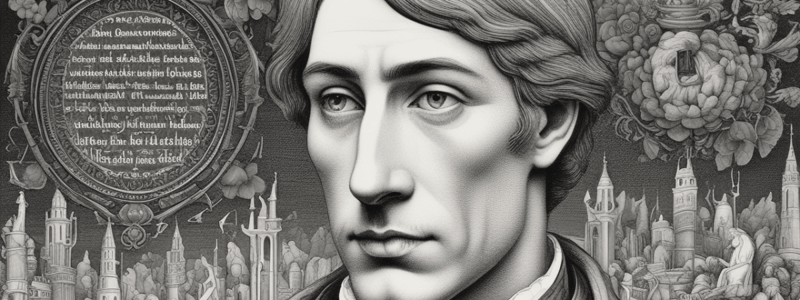Podcast
Questions and Answers
What literary device is used in the line 'Comforter, where, where is your comforting?' and what effect does it create?
What literary device is used in the line 'Comforter, where, where is your comforting?' and what effect does it create?
Anadiplosis; a mirroring effect, where his cries seem to echo and reverberate back as if there is no one listening
What is the significance of the metaphor 'herds-long' in the poem?
What is the significance of the metaphor 'herds-long' in the poem?
It suggests the image of a flock without a shepherd, a man without his God
What point is Hopkins making about understanding mental suffering, and how does he express it?
What point is Hopkins making about understanding mental suffering, and how does he express it?
Hopkins is saying that unless you have experienced mental suffering, you cannot understand its 'abhorrent nature', and he expresses it through the line 'Hold them cheap may who ne’er hung there'.
What comfort, if any, does the poet find in the final lines of the poem, and what is the tone of these lines?
What comfort, if any, does the poet find in the final lines of the poem, and what is the tone of these lines?
Flashcards are hidden until you start studying
Study Notes
Poem Analysis: "No Worst, There Is None" by Gerard Manley Hopkins
Context
- Written in Dublin when Hopkins' mental state was frail and anguish was palpable
- Part of the "Terrible Sonnets" collection
Themes
- Depression
- Suffering
- Feeling of abandonment by God
Style
- Unsettling, dark imagery throughout
- Uses Petrarchan sonnet form
- Powerful metaphors and personification
- Insistent repetition (anadiplosis) and forceful alliteration for emphasis
- Cacophonous assonance
- Rhetorical questions
Key Quotes and Analysis
- "No worst, there is none" : claiming no limit to the extremity of pain
- "Pitched past pitch of grief" : ambiguous verb "pitch" adds layered meaning
- "Wilder wring" : depicts emotional suffering as being torn apart
- "Comforter, where, where is your comforting?" : cry to God, feeling abandoned
- "Herds-long" : metaphor suggesting a flock without a shepherd (no God)
- "Heave" : weight of burden, suffering of all mankind
- "Age-old anvil" : horrific image of torture, no hope of amnesty
- "Fury had shrieked 'No Lingering!'" : referencing Greek mythology, expressing torture
- "O the mind, mind has mountains" : powerful image of insurmountable mental suffering
- "Cliffs of fall Frightful, sheer, no-man-fathomed" : understanding turmoil and depths of the mind
- "Hold them cheap May who ne’er hung there" : unless you've experienced depression, you can't understand
- "Durance deal with that steep or deep" : unable to endure the depths of depression
- "Here! Creep, Wretch, under a comfort serves in a whirlwind" : finding comfort in the midst of depression
- "Life death does end and each day dies with sleep" : life will end, and days end with sleep, offering some solace
Studying That Suits You
Use AI to generate personalized quizzes and flashcards to suit your learning preferences.



